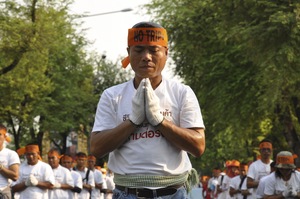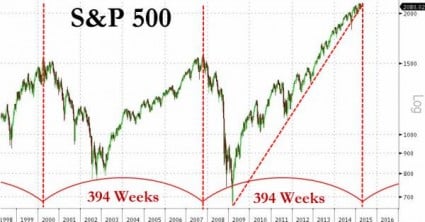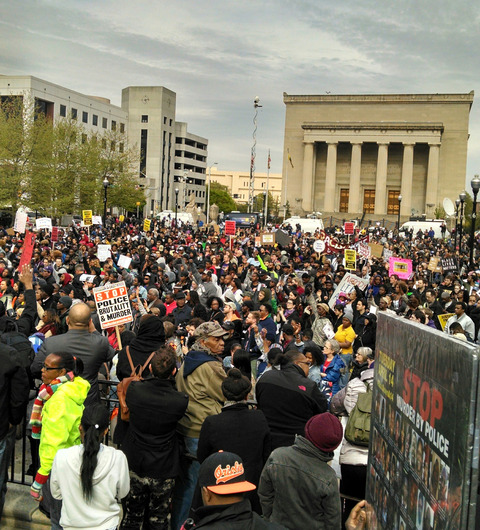La Isla de Pascua o Rapa Nui (Figura 1), es una Isla remota que se presenta con muchos misterios, con una superficie de 166 kilómetros cuadrados (Figura 2) es un microcosmos de nuestro planeta. Aislada en el sur del Océano Pacífico, como nuestro planeta en el espacio, a 3.700 kilómetros de la costa de Chile y a 2.000 kilómetros de la isla de Pitcairn, la isla habitada más cercana, es convertida en un destino para todos aquellos que temen que la humanidad haya entrado dentro de la sexta extinción y quieren entender cómo los rapanui vivieron este drama debido al agotamiento de los recursos vivos de la isla. La vida entró en agonía en un contexto de competencia hasta el punto de agotarse.
Los habitantes de la isla, en una era de abundancia esculpieron estatuas gigantes o moai que representan a los personajes de sus antepasados y también pueden ser un signo de prosperidad y poder. Rapa Nui sigue atrayendo mucha atención de arqueólogos y visitantes de todo el mundo debido a la presencia de estos moai (900) cortados en la toba volcánica y con un gran peso (entre 14 y 80 toneladas) que fueron transportados desde el volcán Rano Raraku (Figura 5) e instalados, hace cientos de años en plataformas sagradas (ahû) (Figuras 6 y 7) por los habitantes de la isla, mientras que no tenían medios técnicos modernos para hacerlo. Este ingenio o mejor dicho esta hazaña de los habitantes de la isla ha llamado la atención de los científicos durante mucho tiempo. La isla fue el escenario de una época de apogeo seguido por una disminución de la población de la isla. Tuvimos casi la extinción de todos los habitantes.
En este ensayo, se describe el proceso de extinción en Rapa Nui y se examina el deterioro “lento” de las condiciones de la existencia actual de la humanidad. A la pregunta planteada a menudo “¿Está la especie humana en peligro de extinción?” Vamos a tratar de responder a esta pregunta: “Sin embargo, a pesar de su pequeño tamaño, la historia de la Isla de Pascua es una siniestra advertencia para la humanidad ” (eco-action.org).
Figura 1. Localizacion de la Isla de Pascua o Rapanui
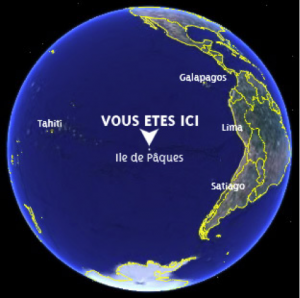
Fuente: http://www.plongeur.com/magazine/2008/07/21/ile-de-paques-rapanui-sejour-et-plongee/4/
Figura 2. Rapa Nui. Vista desde la nave espacial

Fuente: Getaway to The Astronaut Photography of Earth:
http://eol.jsc.nasa.gov/SearchPhotos/ShowQueryResults-TextTable.pl?results=142645902343282
Figura 3. Vista de Rapa Nui – En primer plano la caldera Rano Kau. Atrás se ve el pueblo de Hanga Roa.

Fuente: http://www.webmail.yannarthusbertrandgalerie.com/photo/les-decouvertes/volcan-de-rano-kau-dans-le-parc-national-de-rapa-nui-ile-de-paques-chili.html
Figura 4. Acantilados activos – Ladera de la caldera Rano Kau – Littoral de muy difícil acceso
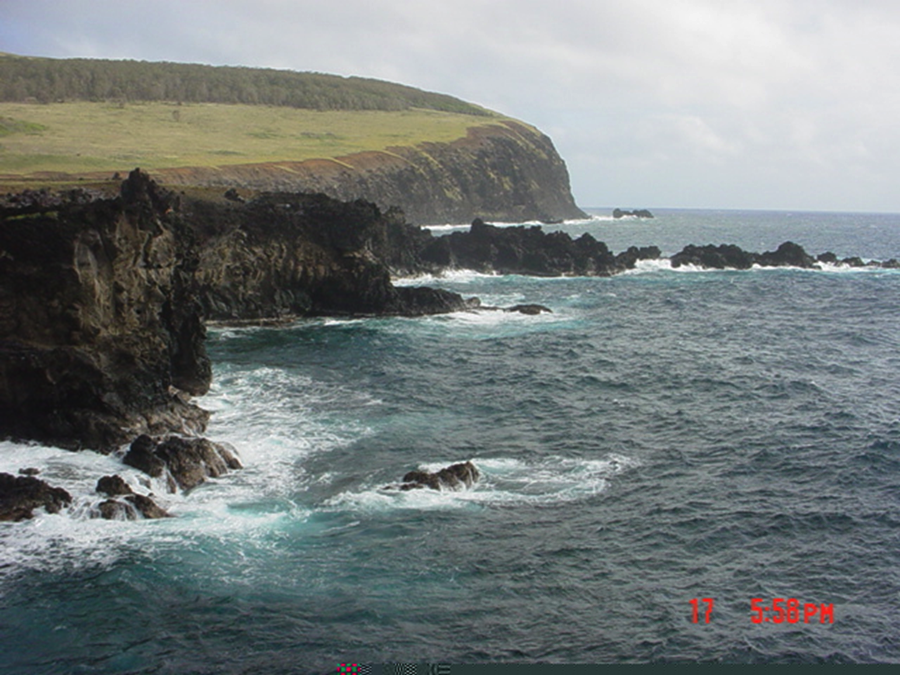
Fuente: Jules Dufour (Octubre 2005)
Las primeras cinco extinciones que han afectado a la tierra. Un recordatorio
“90-99% de las especies que han existido en la Tierra se han extinguido. La gran mayoría desapareció en el contexto de un proceso normal de extinción de especies, debido a la duración limitada de la existencia biológica de estas. Este período varía de unos millones de años con los mamíferos y once millones de años en el caso de algunos invertebrados marinos. Además de esta extinción normal de las especies, nuestro planeta ha experimentado muchas extinciones rápidas de la vida: En los últimos 540 millones años (MA), veinte de más o menos intensidad, se han sucedido. La mayoría son causadas por grandes erupciones volcánicas como lo demuestran las trampas (pilas de flujos de lava que forman acantilados en escaleras)”.
“Algunas eran las extinciones en masa, es decir que han llevado a la desaparición de la mayoría de las especies. Sin embargo, cada vez, estas extinciones han permitido la aparición de nuevas formas de vida, cada vez más diversas y florecientes. Por lo tanto, las extinciones masivas juegan un papel clave en la diversificación de las formas de vida “(http://www.notre-planete.info/environnement/biodiversite/extinctions_massives.php).Veamos las mayores extinciones masivas de la biodiversidad que cambiaron para siempre la vida en la Tierra.
1. « La primera extinción masiva se ha producido en el Ordovícico-Silúrico (444 dC). 85% de la vida marina habría muerto. Las causas no están claramente establecidas, pero desde hace décadas, el mismo supuesto habla que una gran glaciación hubiera dado como resultado el descenso de los niveles del mar. De hecho, un equipo de investigadores ha determinado en 2013 que varias glaciaciones han causado la extinción de la vida marina. Otra hipótesis es apoyada por Brian Thomas, astrofísico (Universidad de Washburn): la radiación gamma puede haber llegado a la Tierra ».
2. « La segunda Devónico-Carbonífero (365 dC) (Devónico-Carbonífero) correspondiente a una serie de acontecimientos que han llevado a la pérdida de alrededor del 70% de las especies animales. Una vez más, se trata esencialmente de las especies marinas que han sido afectadas: arrecifes, braquiópodos y organismos bentónicos. Las causas no están claramente establecidas, sino una glaciación importante que pudo convertirse en niveles del mar más bajos ».
3. « La tercera que ocurrió durante el Pérmico-Triásico (252,6 MA) es probablemente la extinción masiva más grave que la Tierra ha conocido. Más de 90% de todas las especies han desaparecido, tanto en la tierra como en los océanos. Esta extinción masiva se ha llevado gradualmente a cabo durante un período de 200.000 años, con una alta mortalidad. Se concentró en 20.000 años. La biosfera fué devastada: Los bosques de coníferas, helechos, anfibios gigantes, escorpiones marinos, trilobites fueron diezmados… … Muchos de los registros sedimentarios y geoquímicos atestiguan una importante perturbación ambiental durante todo el Triásico (los cinco millones años después de la extinción en masa): ciclo del carbono anormal; océanos ácidos, dióxido poco enriquecido en oxígeno de carbono y sulfuros (CNRS, 09/2011) ».
« Durante 20 millones de años, la Tierra permanece casi estéril y tóxica: los océanos están sustancialmente libres de oxígeno como la atmósfera. Algunas especies sobrevivieron con muy pocos reptiles muy resistentes, diapsidos que toman el lugar de terápsidos (reptiles therapsida) y formaron la línea de los dinosaurios famosos. Se tarda 30 millones de años antes de regresar a la biodiversidad comparable a la de antes de la crisis. Si la vida estuvo cerca de la extinción, esta extinción le permite nuevas formas de vida de diversificarse de una manera sin precedentes. Esta crisis marca el fin de la era primaria o paleozoico y mesozoico temprano, o Mesozoica. Dos escenarios se proponen para explicar esta extinción: La caída de un cometa o la proliferación de un microbio metano ».
4. « La cuarta, el Triásico-Jurásico (200 dC) (Triásico-Jurásico), mata a 20% de las especies marinas, la mayoría de diápsidos (reptiles, aves) y los últimos grandes anfibios. En general, la mitad de la biodiversidad en la Tierra desaparece. Sin embargo, esta crisis permite el auge de los dinosaurios para dominar la Tierra. Las causas aún no están claramente identificadas, y varias hipótesis han sido propuestas ».
“Con la desintegración de la Pangea, erupciones volcánicas masivas que duraron por lo menos 600 000 años se llevaron a cabo en la provincia magmática centro-Atlantica. Este período también corresponde a un aumento de los niveles de dióxido de carbono y a una liberación masiva de metano. De hecho, en la Universidad de Utrecht investigadores han descubierto que al menos 12.000 gigatoneladas de carbono (como el metano) se liberan en la atmósfera durante 20 000-40 000 años. Esto habría llevado un calentamiento global (Bits de Ciencia, 07/2011). Por último, entre otras causas posibles se incluye un meteorito».
5. « La quinta, del Cretácico-Terciario (65 dC). En todos los reinos, cerca de seis a ocho de cada diez especies desaparecieron, los grandes saurios como los dinosaurios famosos incluidos. Los insectos y pequeños mamíferos sin embargo fueron resistentes. Casi todo el plancton marino, un eslabón clave en la cadena alimentaria y de los animales, también desapareció. Parece que no hay animales de más de 20 a 25 kg de masa ha sobrevivido a excepción de los cocodrilos. Se han propuesto varias teorías más o menos cuestionables para explicar esta extinción en masa: lluvia de meteoros, el aumento de actividad volcánica, epidemia explosiva, la intoxicación por las nuevas plantas que contienen alcaloides, reversión del campo magnético de la Tierra, refrigeración, falta de oxígeno… Hoy Dos escenarios son privilegiados: la caída de un meteorito o un vulcanismo importante (notre-planete.info).
Algunos eventos catastróficos han ocurrido durante las primeras cinco extinciones. Se piensa como probable: El impacto de un meteorito, un importante vulcanismo, la liberación masiva de metano y la glaciación.
II. Lo que ha pasado en Rapa Nui
El proceso de extinción o lenta agonía de una población que se manifestó en muchas ocasiones en la historia humana como un ecocidio se define como la destrucción de los ecosistemas (natural o antropogénico) sistemática y total ¿Qué pasó con los Mayas o Incas? Lo que ha ocurrido en Camboya cuando cayó el Imperio Khmer, desde el noveno hasta el siglo XV? De hecho, muchos imperios (hay 77) se han formado y después descendieron hasta la disolución o desmembramiento (wikipedia.org). Sin embargo, lo que sucedió en la Isla de Pascua parece ser el resultado de una acción deliberada hacia la autodestrucción con la disminución de la capacidad de la isla para sostener la vida de las personas y provocando conflictos muy mortíferos causando la muerte de casi la totalidad de la población. Cuando los primeros europeos llegaron a Rapa Nui no habia más que un centenar de personas en la isla. Así que aquí tenemos dos factores importantes en el proceso de extinción: La pérdida irreversible de los recursos vivos y una sangrienta lucha por los que quedan.
Dos fases pueden distinguirse en el destino de Rapa Nui: El ascenso y la caída: “La cultura floreció alrededor del año 1200 y comenzó a declinar en el siglo XVI” (pulsoslp.com).
Según la versión más entendida de los acontecimientos y reportada una vez más por Terry Hunt, un pequeño grupo de colonos polinesios (apodados los nómadas del viento) habría llegado a la isla entre los años 800 y 900 dC arribando por la playa de Anakena (6). Su población se habría incrementado lentamente al principio. Luego, alrededor del 1200 dC su número habría crecido rápidamente y en esta obsesión para tallar, los moai han ejercido una creciente presión sobre el medio ambiente. A finales del siglo 17 los Rapanuis hubieran totalmente deforestado la isla provocando la guerra que fue seguida por el hambre y la decadencia cultural (pulsoslp.com).
El apogeo cultural
Restos arqueológicos de Rapa Nui tienen un valor universal único en el mundo. Son testigos del apogeo qué vivieron los isleños. Es por esta razón que Rapa Nui pertenece a la Lista del Patrimonio Mundial. Según la UNESCO, «ofrece el testimonio de un fenómeno cultural único en el mundo. Asentada en esta isla hacia el año 300 d.C., una sociedad de origen polinesio creó, al margen de toda influencia externa, grandiosas formas arquitectónicas y esculturales dotadas de una gran fuerza, imaginación y originalidad. Desde el siglo X al XVI, construyó santuarios y esculpió numerosos ”moai“, gigantescos personajes de piedra que forman un paisaje cultural inigualable y fascinan hoy al mundo entero. » (unesco.org).
Figura 5. Vista del Volcán Rano Raraku – Sitio de la carrera de los moai

Fuente: Jules Dufour (Octubre 2005)
Según las historias que marcan la llegada de los Polinesios en la Isla por Clive Ponting, los primeros pobladores encontraron allí un entorno con pocos recursos y sobre todo con limitados recursos hídricos. La única agua disponible se encuentra en el interior de cráteres de los tres volcanes extintos de la isla. Lo que es único a Rapa Nui es que la producción agrícola se hizo en los primeros siglos con muy pocos esfuerzos, lo que permitió a los caciques de disfrutar de un montón de tiempo libre, tiempo que podrían dedicar a los rituales y la construcción. Algunas ceremonias se basaron en el culto del pájaro Orongo, donde se encuentran los restos de 47 casas privadas con muchas plataformas y una serie de esculturas de piedra en alto relieve (Figuras 11 y 12). El resultado fue la creación de la sociedad más avanzada de todas las sociedades polinesias y una de las más complejas en el mundo a través de recursos escasos (eco-action.org)
Y Ponting agregó: « Contra todo pronóstico los isleños laboriosamente construyeron durante varios siglos, una de las sociedades más avanzadas de este tipo en el mundo. Durante mil años, han adoptado un estilo de vida de acuerdo con un complejo conjunto de costumbres sociales y religiosas que les permitieron no sólo para sobrevivir, sino para prosperar. Fue en muchos aspectos, un triunfo del ingenio humano y una aparente victoria sobre un entorno difícil. Pero al final el aumento de la población y las ambiciones culturales crecientes de los isleños demostraron ser demasiado grandes para los limitados recursos de la isla. Cuando el medio ambiente fué destruido por la presión demográfica, la sociedad se derrumbó muy rápidamente, lo que incluso llevó a una estado de una casi barbarie » (eco-action.org).
Figura 6. Sector de Tahai. Playa de Anakena

Fuente: Jules Dufour (Octubre 2005)
Figura 7. Tongariti
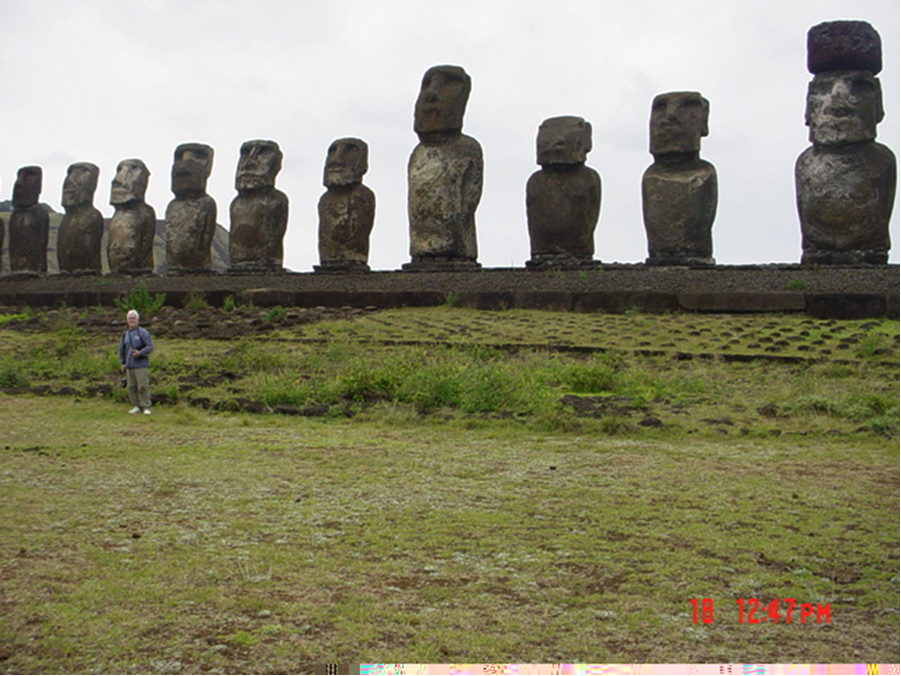
Figura 8. Tongariki

Fuente: Jules Dufour (Octubre 2005)
Figura 8. Moai tallado en basalto del volcán Rano Raraku

Fuente: Jules Dufour (Octubre 2005)
Figura 9. Moai en la ladera del volcán Rano Raraku

Fuente: Jules Dufour (Octubre 2005)
Figura 10. Un moai en Tongariki

Fuente: Jules Dufour (Octubre 2005)
El descenso hacia la extinción y las lecciones para el Planeta Tierra
Según Terry Hunt, en un análisis de la disminución de la población de Rapa Nui, los datos relativos a Jared Diamond, un geógrafo y fisiólogo de la Universidad de California en Los Ángeles, “En el transcurso de algunos siglos”, escribió en 1995 en un artículo para la revista Discover: “La gente de la Isla de Pascua han destruido su bosque, y luego trajeron las plantas y los animales a la extinción, y vieron su sociedad compleja caer en el caos y el canibalismo …” ¿Estamos a punto de seguir su ejemplo? “En su libro « Collapse », publicado en 2005, Diamond describe Rapa Nui como” el mejor ejemplo de una empresa que se ha destruido a sí misma por la sobreexplotación de sus recursos propios. “(americanscientist.org).
Según el mismo autor, Diamond no es el único en percibir lo que sucedió en Rapa Nui. En su libro de la Isla de Pascua, Isla de la Tierra, los autores John R. Flenley de la Universidad de Massey en Nueva Zelanda y Paul G. Bahn expresan su preocupación por lo que la suerte de Rapa Nui significa para el resto de la civilización humana “el apetito de la humanidad no tiene límites, Su egoísmo parece ser genéticamente innato…. Pero en un ecosistema limitado, el egoísmo conduce a aumentar el desequilibrio demográfico y luego a declinar, y en última instancia conduce a la extinción».
Clive Ponting, en su ensayo sobre las lecciones aprendidas de la experiencia de Rapa Nui “el destino de la Isla de Pascua tiene implicaciones más amplias. Al igual que la isla de Pascua el planeta tierra tiene recursos limitados para apoyar a la sociedad humana y sus necesidades. Al igual que los isleños de Pascua, la población humana de la Tierra no es un medio práctico de escape. Cómo el medio ambiente mundial ha dado forma a la historia humana y cómo las personas han dado forma y han cambiado el mundo en el que viven? ¿Acaso han caído las otras sociedades en la misma trampa que los isleños? Durante los últimos dos millones de años, los humanos han logrado conseguir más comida y la extracción de más recursos para apoyar un aumento cada vez mayor de personas y sociedades cada vez más complejas y tecnológicamente avanzadas. Pero han tenido más éxito que los aldeanos en encontrar un modo de vida que no agota fatalmente los recursos disponibles para ellos y para los daños irreversibles del sistema que sostiene la vida “(eco-action.org).
Según Barzin Pakandan, “los habitantes no se atreviron a salir de la isla y decidieron vivir con las consecuencias de tener un mínimo de recursos. También es posible que en esos momentos los isleños sabían que había sobrepoblación. Muy pocos árboles grandes se mantuvieron y fue imposible construir canoas capaces de hacer largas distancias. El hecho es que la población superó los límites de los recursos disponibles e hizo entrar los isleños en la competencia por los recursos y se empeoró aún más la situación “(lse.ac.uk).
Figura 11. Habitación en Orongo
 Fuente Jules Dufour (Octubre 2005)
Fuente Jules Dufour (Octubre 2005)
Figura 12. El motu Kau Kau – El motu Iti – El motu Nui – Islotes de la leyenda del hombre pájaro
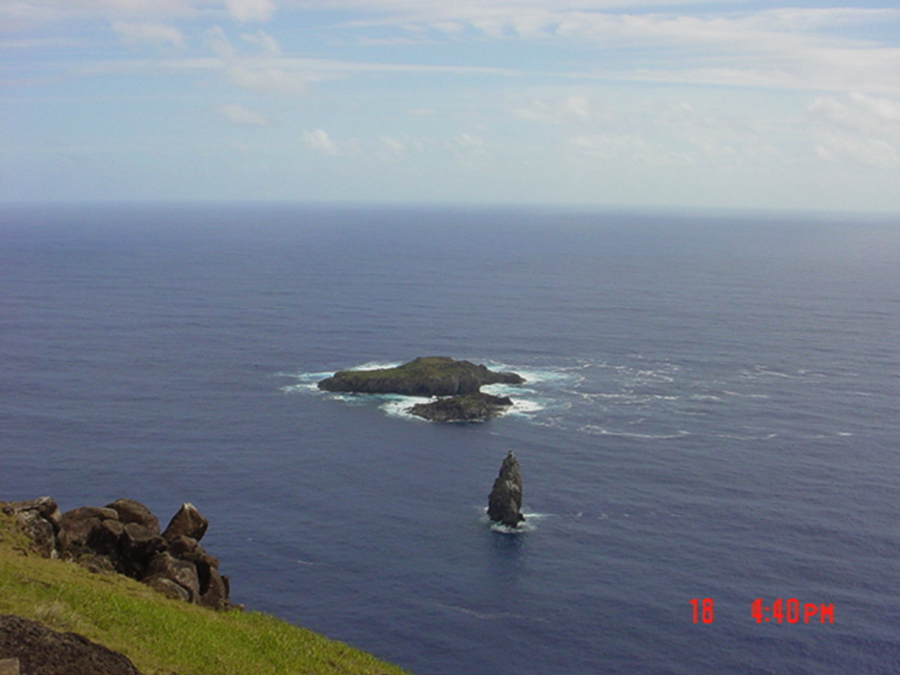
Fuente: Jules Dufour (Octubre 2005)
III. Planeta Tierra
La superficie de la tierra está siendo afectada por los desastres, endógenos y exógenos, muchos, destructivos y mortales. Los más espectaculares son emocionantes: Erupciones volcánicas, terremotos, huracanes, tornados, sequías prolongadas, deslizamiento de tierra y explosión de un pozo de petróleo. Estos eventos se producen y afectan en un tiempo limitado sólo en una parte de la superficie de la tierra. Otros desastres, aquellos más insidiosos y menos dramáticos, que afectan a todos los biomas terrestres y marinos: El calentamiento del clima acelerado e incontrolado, la contaminación de las costas y bahías, la disminución de la tasa de fertilidad natural de los suelos, la contaminación de los océanos y mares y la pérdida de biodiversidad.
Se espera que la población mundial seá de 10 mil millones en 2062
La población mundial, el 16 de marzo de 2015, suma el total de 7,301,603,100 habitantes. Su tasa de crecimiento es actualmente de 1.14% por año. Esto corresponde a un aumento de 80 millones de personas por año. En los años 60 la tasa de crecimiento estaba por encima de 2% y alcanzó un máximo de 2,19% en 1963. Hoy en día se divide por dos.
La tasa de crecimiento anual está disminuyendo y debe continuar en esta dirección en los próximos años. Actualmente, se estima que será un 1% menos, respectivamente, y 0,5% en 2020 y 2050. Esto significa que la población mundial seguirá aumentando durante el siglo 21, pero a un ritmo más lento en comparación con las décadas anteriores. La población mundial se ha duplicado en 40 años (1959-1999), desde 3 mil millones hasta 6 mil millones. Ahora se estima que se necesitarán 43 años para que crezca en un 50% hasta alcanzar los 9 mil millones en 2042. Las simulaciones de la ONU indican que la población mundial se estabilizará en poco más de 10 mil millones de personas después de 2062 (worldometers.info).
Los comportamientos de la extinción
El comportamiento general de la sociedad moderna utiliza un flujo continuo de recursos renovables y no renovables. Los primeros, en teoría, pueden estar disponibles hasta el infinito si se asegura la renovación. Los suelos son intensamente cultivados y pierden gradualmente su productividad natural, mientras que pueden regenerarse a través del uso de la rotación de los cultivos. Las poblaciones de peces disminuyen con la práctica de la pesca industrial, pero se pueden estabilizar si se tiene cuidado en respetar su ritmo de crecimiento y renovación. Las talas de arboles son a veces difíciles, pero ellos crecen bien de nuevo cuando el corte es selectivo. Su conquista sin conciencia conduce a una simplificación de los ecosistemas y poco a poco a una pérdida de la biodiversidad y por lo tanto, una disminución en la productividad de los biomas. En la minería lo mínimo que se requiere es de llevar a cabo la rehabilitación de los sitios abandonados. Muy a menudo este proceso se pospone indefinidamente.
En la extracción de recursos se añaden procesamiento y distribución. Una vez más los comportamientos son dictados por la ideología del crecimiento a cualquier precio, de tal manera que no se toman todas las medidas necesarias para salvaguardar, en particular, el aire y el medio hidrico. Estas actividades tienen muy a menudo un impacto negativo sobre la calidad del medio ambiente.
El hiper-consumismo
Ya lo sabemos. Los patrones de consumo de los países ricos ejercen una enorme presión sobre los recursos alimentarios y los recursos de agua dulce. En el primer caso, la demanda de proteína animal requiere la producción intensiva del suelo. En el segundo caso, las necesidades de agua están aumentando, tanto para uso doméstico como para lo industrial y la energía. Estos procesos se encajan dentro de las sociedades de consumo que siempre quieren más y más.
Tomamos aquí las palabras de Richard Werly en Desarrollo y civilizaciones “, al mismo tiempo, se espera que China y Francia, la India y los Estados Unidos los consumidores de todo el mundo estan invitados a consumir más y, si es necesario, a tener préstamos al consumo. La deuda excesiva que llevó a la crisis ahora es defendida como la solución de la crisis. Esta situación no sólo expresa la ceguera de los líderes del mercado y el gobierno, sino que revela los dilemas más fundamentales del capitalismo consumista que parece incapaz de contenerse sin destruirse pero, si mantiene su ritmo de relámpago de hoy en día, no puede sobrevivir “(lebret-irfed.org).
La pérdida de biodiversidad
Según un estudio presentado en 2008 en la novena Conferencia de las Partes en el Convenio sobre la Diversidad Biológica en Bonn, el costo anual de pérdida de biodiversidad a nivel mundial se estima entre 1.350 y 3.100 millones de euros. Además, la tasa de pérdida de biodiversidad actual es 1000 veces la tasa natural conocida desde la historia de la vida en la Tierra (sciencesenviro.com).
Las necesidades crecientes
La mayoría de la población mundial se ve afectada por la angustia, la miseria y la pobreza. Miles de millones de personas en este planeta no pueden satisfacer sus necesidades básicas. Por otra parte, mil millones de ellos padecen de hambre, el hambre endémica, y casi 30 mil de ellos mueren de hambre cada día (Worldometers – Las estadísticas mundiales en tiempo real (worldometers.info) (Figura 12). Esto indica el hecho de que las desigualdades sociales están creciendo. Sabemos que los más ricos (una minoría muy pequeña) tendra casi el 50% de los ingresos globales. Millones de personas trabajan pero siguen siendo pobres. Según el Observatorio de las desigualdades, “caída de la Pobreza A todo el mundo millones de personas (15 millones en los países ricos) aunque todavía viven con menos de 1,25 dólares al día, la línea de pobreza extrema… y un umbral de algo superior a dos dólares fecha, existen cerca de 2,1 millones de personas pobres, un tercio de la población mundial en 2011 … “(inegalites.fr).
El crecimiento económico no significa mejorar las condiciones de vida de la mayoría. En todas partes, tanto en el Norte como el Sur, las desigualdades sociales están creciendo. Los informes oficiales sobre el estado de la economía mundial están mostrando engañoso optimismo. Señalan que la economía crecerá y al mismo tiempo advierten de que será frenada por factores económicos, tales como la aparición de nuevos conflictos armados, desastres o epidemias. Por otra parte, las desigualdades sociales se ven agravadas por las medidas de austeridad en un gran número de países, contribuyendo al enriquecimiento de una minoría que no está afectada, pero hace una lesión importante de los ingresos de los más pobres. La desigualdad de ingresos en los países en desarrollo está aumentando año tras año, especialmente en África (afriqueexpansion.com).
En resumen, la situación general es parte de este panorama de extinción porque terminamos con una humanidad sin recursos para sobrevivir.
Figura 12. El hambre en el mundo en 2010
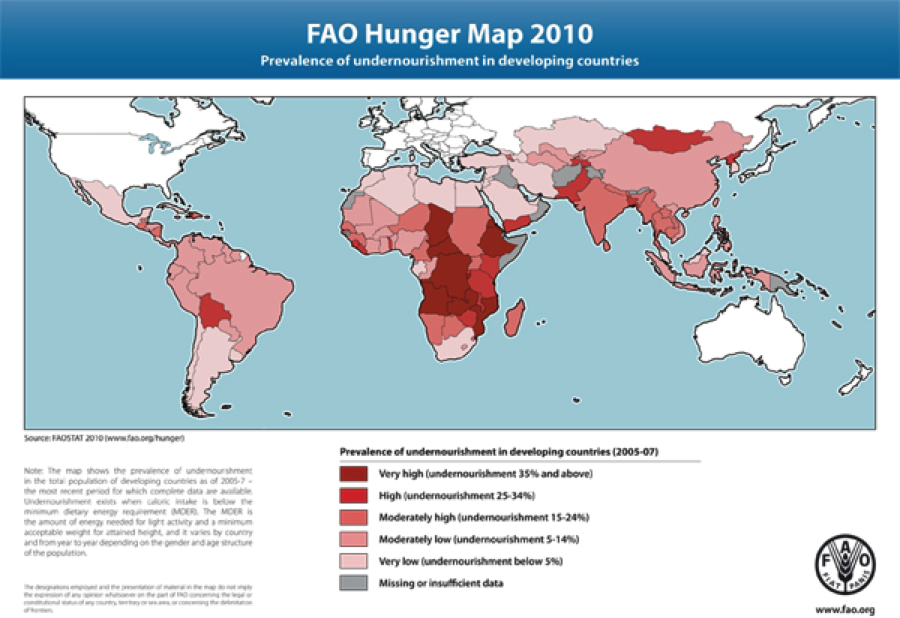
Fuente : http://www.pointsdactu.org/article.php3?id_article=1656
La resolución de conflictos a través de la violencia armada. La humanidad está condenada
La carrera mundial armamentista con la cual seguimos viviendo se presenta también dentro del proceso de extinción de la especie humana. Esta es la mayor amenaza para el futuro de la humanidad. La acumulación de considerables cantidades de armas convencionales y nucleares (El SIPRI estimó el número de ojivas nucleares en el mundo en alrededor de 19 000, 4400 funcionan en enero de 2012), el manteniendo del poder de los Estados poseedores de armas nucleares (los Estados Unidos , Rusia, Reino Unido, Francia y China) constantemente en el proceso de renovación y modernización, brazos prósperos del comercio internacional, lideradas principalmente por los Estados Unidos, China, Rusia y Alemania (globalresearch.ca) y el restablecimiento de todos los países donde los conflictos persisten como todos los países de Oriente Medio o amenazados por países de la OTAN como Rusia, Corea del Norte, Irán y Venezuela. Cuando las bombas vienen del espacio exterior, será demasiado tarde para actuar, que está surgiendo en los planes del Pentágono para 2020 (fas.org).
Conclusion
Este retorno a la Isla de Pascua hace reflexionar sobre el destino de la humanidad. Los rapanuis han encontrado en esta isla comida y otros materiales para vivir de manera aparentemente próspera. Ellos fueron capaces de garantizar la renovación de estos recursos durante siglos. La rápida expansión de la población rompió este equilibrio. El aumento de la presión les llevó a la sobre-explotación de estos recursos e incluso a destruirlos. Esta fue la desaparición lenta de esta cultura única y su agonía a causa de los conflictos sangrientos.
¿Está la humanidad en peligro de desaparecer? ¿Son tan deterioradas las condiciones de su existencia que veremos una clara ruptura en el comercio de la economía mundial? ¿Es que la pérdida de biodiversidad causará una fuerte disminución de la producción de los recursos vivos? ¿El agotamiento de los recursos energéticos fósiles causará un conflicto armado generalizado? A principios del Tercer milenio las perspectivas no son tan buenas. Muchos de los síntomas de la mala salud del planeta crean ansiedad en todo el mundo. ¿Habíamos entrado en este proceso de decadencia que ha vivido Rapa Nui o lo que se llama la sexta extinción? Según Anne Larigauderie, director ejecutivo del programa DIVERSITAS internacional – cuya secretaría se encuentra en el Museo Nacional de Historia Natural de París, se le preguntó acerca de esto en la Cumbre de Río + 20, « podemos decir que estamos avanzando hacia una potencialmente sexta extinción, pero que la acción aún se puede tomar (esta es la buena noticia!) para influenciar el curso de los acontecimientos. Por lo tanto, debemos seguir siendo optimistas, pero actuar con rapidez! (sciences.blogs.liberation.fr).
Segun notre-planète tomando las palabras del famoso científico australiano Frank Fenner publicadas en The Australian, la especie humana está en peligro de desaparecer, “Para Fenner, hemos sellado el destino de la humanidad en menos de 100 años, Las sociedades humanas ya no son… “Homo sapiens desaparecerá, tal vez en 100 años”, dijo. “Una gran cantidad de otros animales también. Esta es una situación irreversible. Creo que es demasiado tarde. Trato de no decirlo demasiado porque hay gente tratando de hacer una diferencia. Los esfuerzos de reducción disminuyen un poco las cosas, pero ya hay demasiada gente [en la Tierra] “, añade.” “La explosión de la población y sus corolarios: energía, productivistas y bulimia consumista conducen a la humanidad a su pérdida. Esto, tabú, es, sin embargo cada vez más compartido por algunos científicos y cada vez se menciona, pero sofocado por los escépticos sobre el cambio climático y algunas de las personas religiosas para quienes la reproducción es una recomendación divina dice Frank Fenner ” (notre-planete.info).
Impulsar aún más la genesis de la agonía de la vida debe ser el trabajo de todos. Factores más poderosos, como el “crecimiento a cualquier costo” habilitados por el hiper-consumismo promueven aún más la explotación de los recursos vivos y el deterioro de las condiciones para su renovación. Estos factores deben ser contrarrestados para asegurar la supervivencia de la humanidad.
El concepto de la supervivencia en la tierra significa que los recursos terrestres e hídricos son limitados y que sólo un enfoque que respete la renovación de los ecosistemas podría asegurar la supervivencia de la humanidad. Lo que se debe evitar absolutamente es la pérdida de la biodiversidad. Esto asegura el mantenimiento del equilibrio natural y la renovación de los recursos vivos. Sabiendo que la era industrial y que el consumismo han tenido un impacto considerable en el medio ambiente, la Unión Internacional para la Conservación de la Naturaleza (UICN), junto con el WWF y el PNUMA, lanzaron la estrategia mundial de la Conservación en 1980, y la Estrategia para una Vida Sostenible en 1991. Ambas estrategias y los diversos acuerdos internacionales que siguieron, acompañados de la Carta de la Tierra son los pilares en el centro de los esfuerzos de conservación de los recursos mundiales. A éstos hay que añadir la red mundial de áreas terrestres y marinas protegidas.
Hoy en día, la conquista y el control de las reservas de recursos se hacen por la violencia armada. Los Estados Unidos, por ejemplo, aplican el principio de la “guerra permanente” para garantizar la seguridad del suministro de los recursos estratégicos. Dividieron la superficie de la tierra en seis mandamientos que garantizan sus intereses. Consideran la superficie de la Tierra como un campo de batalla y que la guerra es la mejor manera que se debe utilizar para mantener su hegemonía sobre el conjunto del planeta (Figura 13). Incluso la Antártida está bajo su control. Otras potencias siguen controlando territorios con la misma intención y con el mismo enfoque.
Figura 13. Los seis mandamientos estadounidense que cubren toda la superficie de la tierra

Source : http://www.abovetopsecret.com/forum/thread963236/pg1
Así que tenemos los dos ingredientes de la extinción como lo hemos observado en la Isla de Pascua: La destrucción de los recursos vivos y los conflictos armados para salvaguardar los recursos estratégicos conocidos. Sólo un gobierno mundial con poderes reales podría actuar sobre estos factores. Por desgracia, las grandes potencias trabajan para que el orden establecido se mantenga.
Para terminar citamos la Carta de la Tierra que establece la situación ambiental global del planeta y ofrece 16 principios para la acción ambiental.
El texto de la Carta está estructurado en torno a 4 principios básicos o angulares, desplegados en 16 principios generales, desarrollados y complementados a su vez en 61 principios de detalle o de apoyo. Todos ellos van precedidos de un Preámbulo, y finalizan con un texto de conclusión (earthcharterinaction.org).
Éstos son los 16 principios generales:
“La protección de la vitalidad, la diversidad y la belleza de la Tierra es un deber sagrado” (Preámbulo de la Carta).
I. Respeto y cuidado de la vida
1. Respetar la Tierra y la vida en toda su diversidad.
2. Cuidar la comunidad de la vida con entendimiento, compasión y amor.
3. Construir sociedades democráticas que sean justas, participativas, sostenibles y pacíficas.
4. Asegurar que los frutos y la belleza de la Tierra se preserven para las generaciones presentes y futuras.
II. Integridad ecológica
5. Proteger y restaurar la integridad de los sistemas ecológicos de la Tierra, con especial preocupación por la diversidad biológica y los procesos naturales que sustentan la vida.
6. Evitar dañar como el mejor método de protección ambiental y, cuando el conocimiento sea limitado, proceder con precaución.
7. Adoptar patrones de producción, consumo y reproducción que salvaguarden las capacidades regenerativas de la Tierra, los derechos humanos y el bienestar comunitario.
8. Impulsar el estudio de la sostenibilidad ecológica y promover el intercambio abierto y la extensa aplicación del conocimiento adquirido.III. Justicia social y económica
9. Erradicar la pobreza como un imperativo ético, social y ambiental.
10. Asegurar que las actividades e instituciones económicas, a todo nivel, promuevan el desarrollo humano de forma equitativa y sostenible,
11. Afirmar la igualdad y equidad de género como prerrequisitos para el desarrollo sostenible y asegurar el acceso universal a la educación, el cuidado de la salud y la oportunidad económica.
12. Defender el derecho de todos, sin discriminación, a un entorno natural y social que apoye la dignidad humana, la salud física y el bienestar espiritual, con especial atención a los derechos de los pueblos indígenas y las minorías.IV. Democracia, no violencia y paz.
13. Fortalecer las instituciones democráticas en todos los niveles y brindar transparencia y rendimiento de cuentas en la gobernabilidad, participación inclusiva en la toma de decisiones y acceso a la justicia.
14. Integrar en la educación formal y en el aprendizaje a lo largo de la vida, las habilidades, el conocimiento y los valores necesarios para un modo de vida sostenible.
15. Tratar a todos los seres vivientes con respeto y consideración.
16. Promover una cultura de tolerancia, no violencia y paz.
La Carta finaliza con estas alentadoras palabras:
Que el nuestro sea un tiempo que se recuerde por el despertar de una nueva reverencia ante la vida; por la firme resolución de alcanzar la sostenibilidad; por el aceleramiento en la lucha por la justicia y la paz; y por la alegre celebración de la vida (wikipedia.org).
Jules Dufour
Para el Centro de Investigación sobre la Globalización (CRM), Montreal, Canada
Jules Dufour, PhD, C.Q, geógrafo, profesor emérito, Miembro de la Comisión Mundial de Áreas Protegidas de la Unión Internacional de la Naturaleza (UICN), Gland, Suiza, Miembro del Círculo de Embajadores de la Paz Universal, París y Ginebra.
Referencias
ANONYME. 2014. Les extinctions massives de la biodiversité. Notre-planete-info. Le 3 décembre 2014: http://www.notre-planete.info/environnement/biodiversite/extinctions_massives.php
BRESSAN, David. 2011. Climate, Overpopulation & Environment – The Rapa Nui debate. Blogs. History of Geology. Le 31 octobre 2011: http://blogs.scientificamerican.com/history-of-geology/2011/10/31/climate-overpopulation-environment-the-rapa-nui-debate/
CHAROLA, A. Elena. 1997. Isla de Pascua. El Patrimonio y su Conservacion. World Monument Fund con el Auspicio del Willard and Ruth Sommerville Bequest. 1997. 68 pages.
CHOSSUDOVSKY, Michel. 1998. La mondialisation de la pauvreté. Montréal, Les Éditions écosociété. 248 pages.
CHOSSUDOVSKY, Michel. 2003. Mondialisation de la pauvreté et nouvel ordre mondial. Montréal, Les Éditions écosociété. 383 pages.
CHOSSUDOVSKY, Michel. 2015. Globalization of War : America’s « Long War » against Humanity. Global Research, Montréal, 2015, 240 pages.
CLINE, Eric. H. 2014. 1177 B.C. The Year Civilization Collapsed. Our eBook editions. 264 pages.
COMMISSION CANADIENNE POUR L’UNESCO. 1989. La Déclaration de Vancouver. Actes du colloque de l’Unesco. La science et la culture pour le 21ème siècle : Un programme de survie. Vancouver, Canada, 10-15 septembre 1989. 335 pages.
DANGEFIELD, Withney. 2007. The Mystery of Easter Island. New findings rekindle old debates about when the first people arrived and why their civilization collapsed. Le 31 mars 2007. Smithsonian.com: http://www.smithsonianmag.com/people-places/the-mystery-of-easter-island-151285298/#wdIjh54Vi3ydI2jw.
DUFOUR, Jules. 1994. Déséquilibres et périls planétaires. In : Forêt verte, planète bleue. Montréal, Éditions Fides et Musée de la Civilisation, pp. 22-49.
DUFOUR, Jules. 2015. La conjoncture mondiale 2015: le risque d’une conflagration « nucléaire » pointe de nouveau à l’horizon. Montréal, Centre de recherche sur la mondialisation (CRM). Le 18 février 2015: http://www.mondialisation.ca/la-conjoncture-mondiale-2015-le-risque-dune-conflagration-nucleaire-pointe-de-nouveau-a-lhorizon/5431693
DUFOUR, Jules. 2015. La militarisation planétaire s’intensifie. Les drones de combat sèment la terreur et la mort. Montréal, Centre de recherche sur la mondialisation (CRM). Le 3 mars 2015: http://www.mondialisation.ca/la-militarisation-planetaire-sintensifie-les-drones-de-combat-sement-la-terreur-et-la-mort/5434583
HUET, Christophe. 2012. Rio +20, la biodiversité en péril ? Libération. Le 19 juin 2012: http://sciences.blogs.liberation.fr/home/2012/06/rio-20-la-biodiversit%C3%A9-en-p%C3%A9ril-.html
HUNT, Terry. Rethinking the Fall of Easter Island. New evidence points to an alternative explanation for a civilization’s collapse. American Scientist. En ligne : http://www.americanscientist.org/issues/pub/rethinking-the-fall-of-easter-island
LA CHARTE DE LA TERRE. Valeurs et Principes pour un Avenir Durable. Secrétariat International de la Charte de la Terre. Université pour la Paix, Costa Rica: http://www.earthcharterinaction.org/contenu/pages/La-Charte-de-la-Terre.html
LA FAIM DANS LE MONDE. Les causes de la faim dans le monde: http://faimdanslemonde.e-monsite.com/pages/le-probleme-de-la-faim-en-constant-developpement.html#G7lPrvzjjS2i7O4z.99
LEE, Georgia. Texte. Tony Catany. Photographie. 1995. RAPA NUI. HISTOIRE DE L’ÎLE DE PÂQUES. Genève, Éditions Olizane. 222 pages.
LeMonde.fr. Île de Pâques : Les statues qui marchent. Ulysse. Le 5 août 2011: http://www.lemonde.fr/voyage/article/2011/08/05/ile-de-paques-les-statues-qui-marchent_1556451_3546.html
MAZIÈRE, Francis. Fantastique île de Pâques. Paris, Robert Laffont, 1969. 268 pages.
NOTRE-PLANETE-INFO. 2013. “Il est déjà trop tard” : l’espèce humaine devrait s’éteindre ce siècle. Le 23 mars 2013: http://www.notre-planete.info/actualites/actu_2447_extinction_espece_humaine.php
PAKANDAM, Barzin. 2009. Why Easter Island Collapsed: An Answer for an Enduring Question. Working Papers No. 117/09: http://eprints.lse.ac.uk/27864/1/WP117.pdf
REUTERS. 2014. Antiguos habitantes de Isla de Pascua no estaban tan aislados. Puso. Diario de San Luis. Le 23 octobre 2014: http://pulsoslp.com.mx/2014/10/23/antiguos-habitantes-de-isla-de-pascua-no-estaban-tan-aislados/
SCIENCEVIRO. 2012. Les frontières à ne pas dépasser. Le 30 octobre 2012. En ligne : http://sciencesenviro.com/2012/10/30/les-frontieres-a-ne-pas-depasser/
UN. 2014. World Economic Situation Prospect. Global economy to improve marginally, but mounting uncertainties and risks could undermine economic growth, says UN. Le 19 janvier 2014: http://www.un.org/en/development/desa/policy/wesp/wesp_archive/2015wesp-pr-gl-en.pdf
WIKIPÉDIA. L’île de Pâques: http://fr.wikipedia.org/wiki/%C3%8Ele_de_P%C3%A2ques
Vidéos
HISTORY. Easter Island Videos: http://www.history.com/topics/easter-island/videos/historys-mysteries-easter-island
L’énigme de l’île de Pâques. Français explorateur: https://www.youtube.com/watch?v=U6BqNH8iqjU




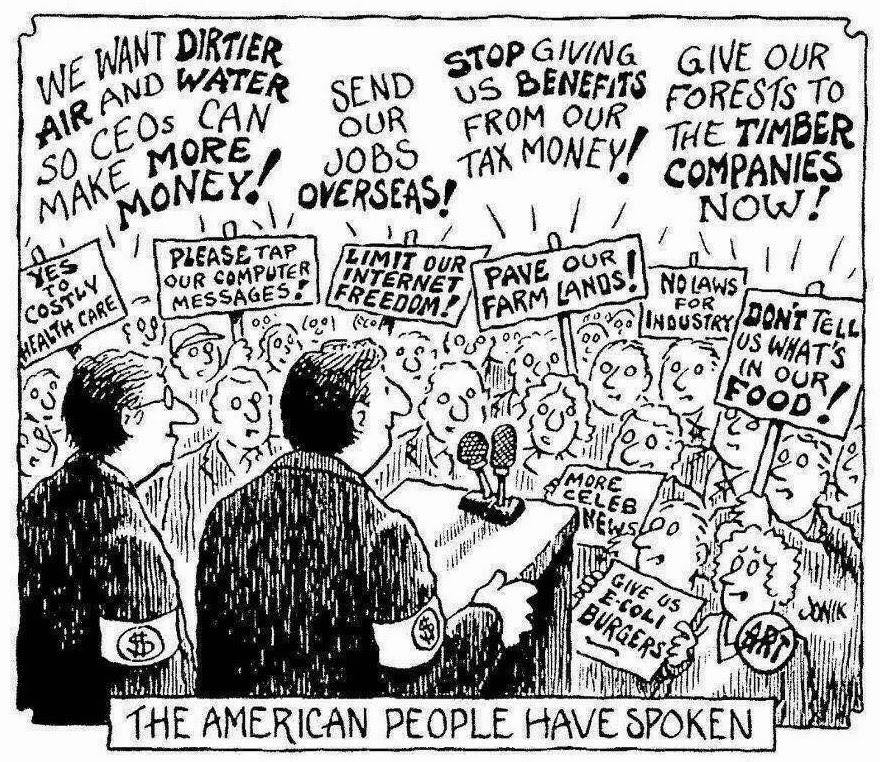

 Click here to download this article as a PDF file
Click here to download this article as a PDF file
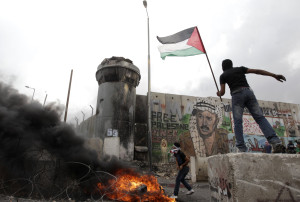

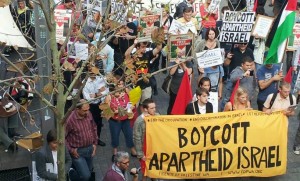
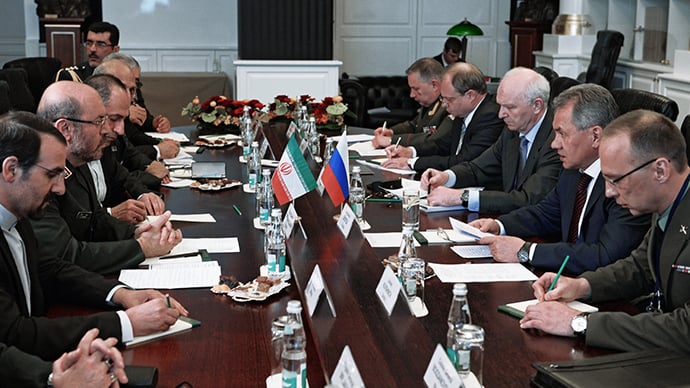
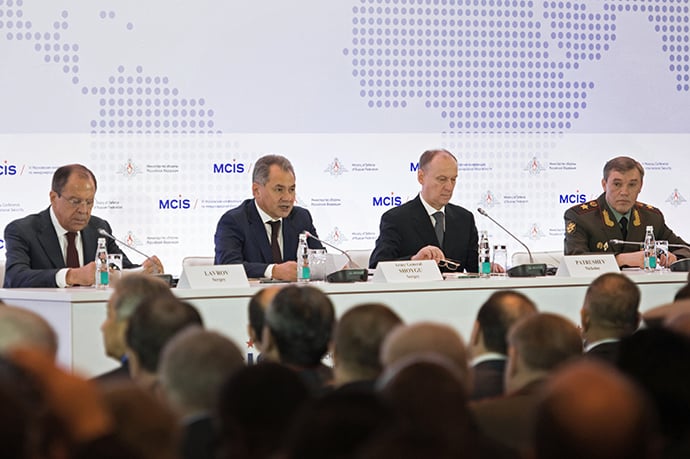
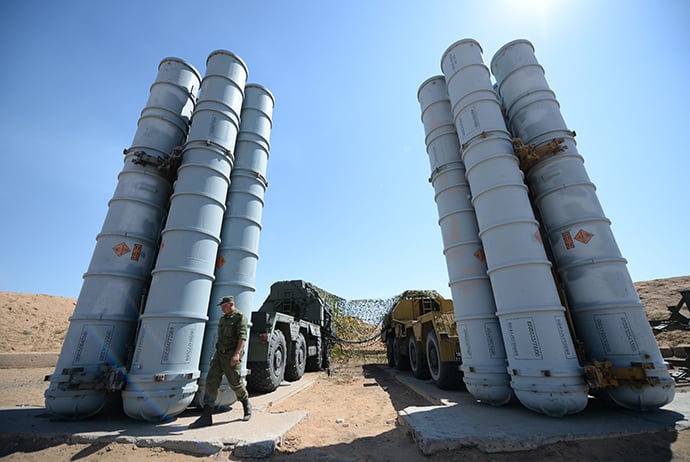
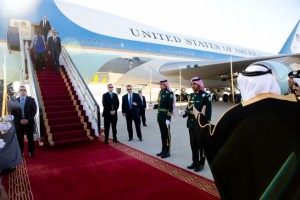










 Fuente Jules Dufour (Octubre 2005)
Fuente Jules Dufour (Octubre 2005)





